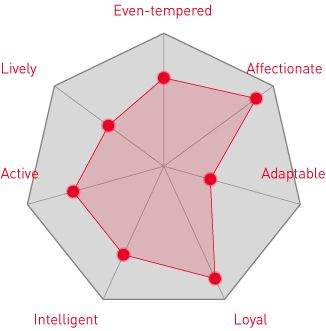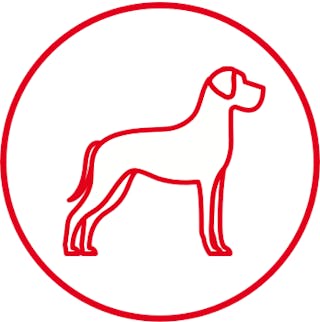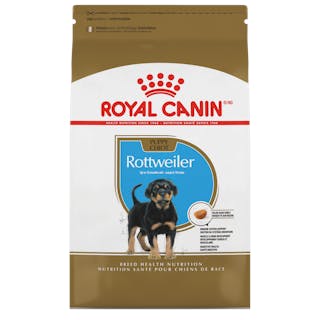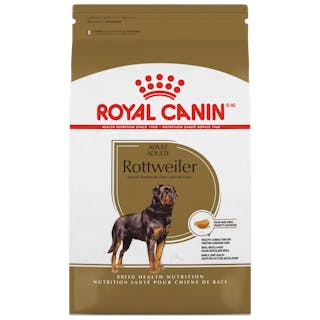
Let's talk Rottweilers
Despite their fierce reputation and formidable size, the Rottweiler is a loyal and devoted breed with an affectionate, obedient and surprisingly gentle temperament. Nonetheless, thanks to their fearless disposition, natural intelligence and powerful frame, they are also one of most popular guard dogs in the world. As a result, Rottweilers tend to do best with an experienced owner who can take on the role of ‘pack leader’.Official name: Rottweiler
Other names: Rottie, Rottweiler Metzgerhund, Butcher’s Dog of Rottweil
Origins: Germany

| Drooling tendencies |
|
Warm weather? |  |
| Grooming needs |  |
Cold weather? |  |
| Shedding level |  |
Suited to apartment living? |  |
| Barking tendencies | Medium | Can stay alone?* |  |
| Energy Level (high, low, medium)* | High | Family pet?* |  |
| Compatibility with other pets |  |
* We advise against leaving pets alone for long stretches. Companionship can prevent emotional distress and destructive behaviour. Speak to your veterinarian for recommendations.
Every pet is different, even within a breed; this snapshot of this breed specifics should be taken as an indication.
For a happy healthy and well-behaved pet, we recommend educating and socializing your pet as well as covering their basic welfare needs (and their social and behavioral needs).
Pets should never be left unsupervised with a child.
Contact your breeder or veterinarian for further advice.All domestic pets are sociable and prefer company.
However, they can be taught to cope with solitude from an early age. Seek the advice of your veterinarian or trainer to help you do this.


| Baby age | Birth to 2 months |
| Puppy age | 2 to 8 months |
| Adult age | 8 months to 2 years |
| Mature age | 2 years to 5 years |
| Senior age | 5 to 16 years |

1/7
Get to know the Rottweiler
All you need to know about the breed
Often depicted in films and in the media as an aggressive or dangerous dog, the personality of the Rottweiler couldn’t be more different in real life. While it’s true that they are strong, powerful and can be trained to tackle a criminal if required, they are generally big softies at heart. With the right guidance from an experienced owner, they are docile, respectful and very gentle dogs who will soon become a devoted companion.
Naturally protective of their clan, Rottweilers form very strong bonds with their human families. But, as existing owners will attest, they have a great sense of playfulness too. They enjoy snuggling up with their preferred humans and will even try to sit on your lap if you let them.
One of the oldest breeds in the world, the history of the Rottweiler dates back to Roman times when they were used for herding cattle. Today, as well as being a much-loved family pet, the Rottweiler’s powerful, bulky frame and innate intelligence means they are often utilised as guard dogs. Always tuned in to what is going on around them, they respond well to working situations.
As well as being a popular choice for the police, they are often seen at the side of security guards, and are used as search-and-rescue dogs, too. Undoubtedly, this has added to their reputation.
With their statuesque size, the Rottweiler certainly makes a formidable sight. Large, muscular and energetic, they are also very beautiful animals. Sporting a smooth dark coat, peppered with flecks of rust, they have expressive, dark-brown eyes and a powerful, waggy tail.
One other thing to bear in mind with the Rottweiler is that they do need plenty of exercise. Ideally, they should have a minimum of two hours physical activity every day. Yes, at least two hours. But as long as they get this, along with the right training and socialisation, they are sure to become an integral member of your family pack.

2/7
2 facts about Rottweilers
1. Busting the myths
Any potentially dangerous behaviour in Rottweilers almost always stems from either a bad owner or a lack of socialisation and training. So these are important considerations for this breed, especially given their immense strength. For more information on training your Rottweiler, see below.
2. All in the breeding
During the 1990’s, the Rottweiler became one of the most sought-after dogs in the US and this resulted in many less than ethical breeders – leading to animals with health problems and/or a bad temperament. It’s always worth investing the time to find a respected and trusted breeder.
History of the breed
One of the world’s oldest dog breeds, the Rottweiler is originally descended from the Molossus, a type of mastiff. Back in Roman times, these sturdy dogs were used to herd cattle and keep guard. Later, they accompanied the Roman legions on their epic journeys across the Alps. When the Romans reached Germany, where they set up colonies, their dogs met and mixed with the native breeds. This resulted in the Rottweiler that we know today.
Named after the small town of Rottweil, which became a centre for cattle commerce, the dogs continued their work as herding animals. However, they were also adopted by local butchers as a dependable draught dog – and even became known as Rottweiler Metzgerhunds (butcher dogs).
Later, in the early 1900’s, Rottweilers became the favoured choice for the police service – paving the way for their reputation as a guard dog. They were officially recognised by the American Kennel Club in 1931, but it wasn’t until after World War Two that their popularity really took off. Of course, they went on to become equally renowned as a household pet.
Interestingly, Rottweilers were also among the first guide dogs for the blind – and, more recently, they have been celebrated for their search-and-rescue work. Now, despite the rather negative depiction they often receive in the media, they are a firm favourite among dog-lovers worldwide.

4/7
From head to tail
Physical characteristics of Rottweilers
1. Head
Skull is of medium length, and broadest between the ears, with a well-developed nose.
2. Eyes
Dark-brown eyes often arched above with two spots of rust-coloured fur.
3. Body
Powerful, muscular body with a firm and straight back and thickly-muscled hindquarters.
4. Fur
Medium-length, double coat is coarse and flat with black and tan markings
5. Tail
Long and slightly bushy tail balances out the breed’s impressive frame.

5/7
Things to look out for
From specific breed traits to a general health overview, here are some interesting facts about your Rottweiler
Watch out for wear and tear on their limbs
One of most common health problems in Rottweilers is a hereditary condition called ‘hip dysplasia’ – a malformation of the joint. When this occurs, dogs will often show pain or lameness on one or both rear legs, though that isn’t always the case. In later life, the condition can often lead to arthritis. However, a reputable breeder will have the hips and elbows of all parent dogs X-rayed, thereby minimising the risk. High-quality nutrition, regular exercise and maintaining a good weight in your Rottweiler can all help to support healthy joints.

6/7
Caring for your Rottweiler
Grooming, training and exercise tips
As highly muscular and athletic dogs, adult Rottweilers need plenty of exercise and interaction to keep them in peak condition, both mentally and physically. To help burn off some of that excess energy, and for a zen state of mind, they will need at least two hours of exercise each day. Ideally, they will also benefit from a wide secure space where they can charge around at full pelt and let off some steam. As Rottweilers can be just as playful as puppies even into adulthood, they will appreciate games in the garden too. They also enjoy swimming if there is a safe place for them to do so.
With their medium-length double coat, the Rottweiler requires weekly brushing to keep their fur in peak condition. For most of the year, moulting is fairly moderate – although it can be more noticeable at the Rottweiler’s seasonal shedding times in the spring and the autumn. Be prepared for some drooling too. They will benefit from regular baths – though, given the size of the Rottweiler, many owners choose to book them in for professional grooming sessions. The Rottweiler’s nails should be trimmed as needed, ears checked regularly and teeth brushed as often as you can manage – at least two or three times a week but daily if possible. The key with this is to get them used to it when they’re young so they know that it’s nothing to fear.
Starting from a young age, it’s important that your Rottweiler recognises you as ‘pack leader’. Otherwise, he’ll think he’s ‘top dog’. For this reason, the Rottweiler is not a good choice for first-time owners. However, with a kind but firm human, and the right training, the Rottweiler puppy will grow into a happy, confident adult. Also, as the Rottweiler has a natural protective instinct, it’s important to socialise them early on so they’re at ease with other people and animals. Highly intelligent, they learn quickly and will enjoy the mental stimulation of training classes. For best results, always use positive reinforcement and reward-based techniques.
7/7
All about Rottweilers
Although opinions can vary on this topic, female Rottweilers are generally viewed to be a little bit gentler and less boisterous than the males. But with the right training – and importantly the right owner – both genders can make devoted pets. On a related note, it’s also worth thinking about the pros and cons of sterilisation. For example, this can reduce aggressiveness in both males and females, though there is a greater risk of weight gain if the diet is not monitored. Lastly, one other benefit of choosing a female is that they typically live a couple of years longer.
With their thick double coat, Rottweilers do okay in winter weather but are still more sensitive to the cold than you might think. They can also struggle in hot temperatures, so their exercise should always be timed accordingly. Access to shade and an ample supply of water are musts. So, despite that tough-guy reputation, Rottweilers are more sensitive to weather extremes than you might expect.
Read more on this topic


How to adopt a dog

Things to consider before getting a dog
Sources
1 - Veterinary Centers of America https://vcahospitals.com/
2 - Royal Canin Dog Encyclopaedia. Ed 2010 and 2020
3 - Banfield Pet Hospital https://www.banfield.com/
4 - Royal Canin BHN Product Book
5 - American Kennel Club https://www.akc.org/



